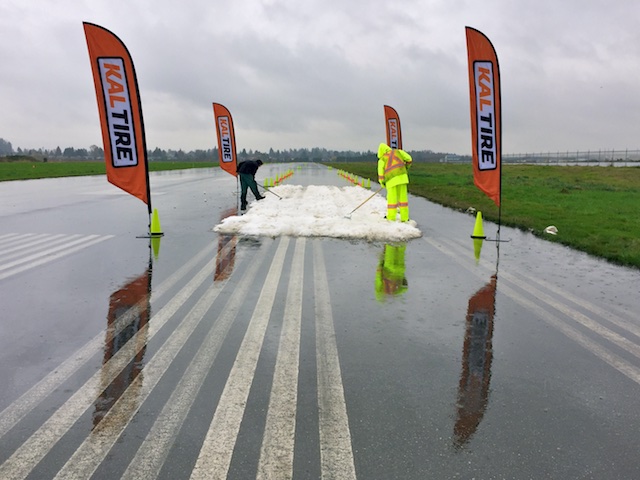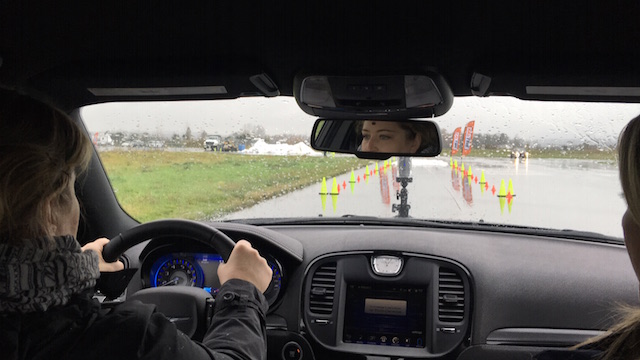Testing Tires in Winter Conditions with Kal Tire
Have you seen the meme that’s going around showing several cars spun out in a ditch off a snowy highway with the caption “annual meeting of the summer tires club”? It’s rather funny, until you check the tires on your own car or, heaven forbid, you end up in a skid on a patch of black ice or snow in our mountain passes. However, it does bring awareness to tire choice given seasonal conditions.
I took to a closed course in Pitt Meadows with Kal Tire recently to put some 3-season and winter tires to the test, trying both new and worn versions of each tire set in the pouring rain — and on some imported snow — to see how different types of tires perform in winter driving conditions.
Testing Tires in Winter Conditions with Kal Tire
I love driving, so much, and I think part of it comes from having experience on closed courses, where I can really put a vehicle and its tires to a test. This was my fifth closed course experience and it really put my skills to the test, especially since I knew I would be driving worn tires over giant puddles and patches of snow.
“When we test what we want to do is take the driver and the suspension input of the vehicle out of the equation, so that we’re just testing the tread of the tires.”
My co-pilot was an independent tire tester and pro-driver, Joanne Younker, who is based in Whistler.
Joanne has tested hundreds of tires, and they’re all blind tests so she never knows what’s being put on the car when she’s doing her diagnostics and providing professional input. For our run, she made sure that I was going the same speed and applying the same quickness and power to the ABS (anti-lock braking system) during each run so I truly relied on the tires for feedback instead of my own movements.

To ensure accurate results, scientific data was collected by professional drivers (Joanne included) over multiple runs using industry-leading technology that measured precise driving lines, speed, G-force measurements, GPS information and even minute track conditions such as road and wind temperature.
Kal Tire evaluated the performance of various tires at five stages of tread wear—from brand new to zero tread depth. One of the key findings shows even a worn premium winter tire can outperform a new 3-season tire in certain conditions. The tests were done in several conditions, which were replicated during my run: cold dry, cold wet, ice, slush, and snow.
Results
A worn five-star premium tire can outperform a new 3-season tire in certain conditions.
Ice braking: On an icy road at 30 km/h, the 75% worn five-star premium winter tire stopped in 29.7m; 2.6m sooner than the new 3-season, which stopped at 32.3m.
Snow cornering: The 75% worn premium winter tire held a corner 4.3% better than the new 3-season tire.
No two winter tires are created equal. The five-star premium winter tire outperformed the three-star economy winter tire in all tests over all stages of wear.
Ice braking: The 75% worn premium winter tire stopped in 29.7m; the 75% worn economy winter tire stopped in 32.5m.
Snow cornering: The 75% worn premium winter tire cornered 26% better than the 75% worn economy winter tire.
Braking performance declines significantly between 50% and 75% wear.
Ice braking: When the premium winter tire went from 50% to 75% worn, it took an extra 3.1m to brake on ice. The economy winter tire took an extra 4.8m.
Snow braking: When the premium tire went from 50% to 75% worn, it took an extra 4.4 m to brake on snow. The economy winter tire took an extra 4.3 m to stop.
Most tire purchases are made out of necessity, after something goes wrong, but learning more about the performance of tires in various types of conditions might help us all make more proactive decisions about what we put on our vehicles. You can find out more by visiting your local Kal Tire where you can browse brands and get the best advice for your all-season driving.











